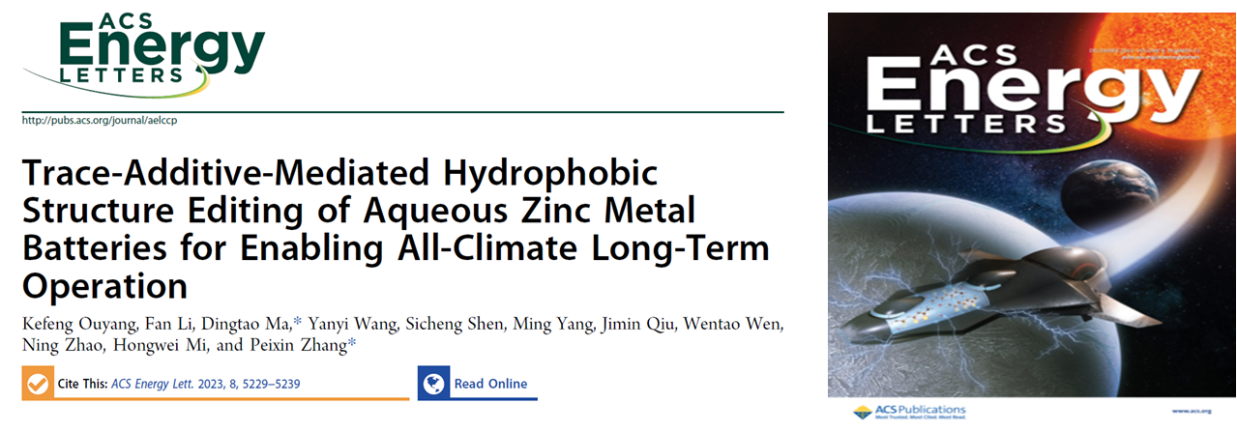As two new types of batteries, both sodium and zinc ion batteries show good application prospects, however, their applications still face several key challenges. Since 2023, Prof. Peixin Zhang's research group has carried out in-depth and systematic research on the key materials such as anode and cathode materials, electrolyte, and separator of sodium/zinc ion batteries on the basis of their past work, and has obtained a series of innovative research results. Relevant research results have been published in high-level journals such as Advanced Materials, Angewandte Chemie International Edition, Advanced Energy Materials, ACS Energy Letters, Advanced Functional Materials, Nano-Micro Letters, Energy Storage Materials, and Journal of Energy Chemistry.
In order to solve the problems of low capacity and poor cycling performance of transition metal compounds as anode materials for sodium-ion batteries, a unique in situ functionalization and self-limiting growth method is proposed to design VSe2-x/C in-plane heterojunctions with built-in bifunctional anion vacancies. As demonstrated, the multiscale interfacial synergies between the bifunctional anion vacancies and the in-plane heterostructures alleviated the bulk strain and improved the kinetics and thermodynamics of the Na+ intercalation and the subsequent conversion reactions. The results were published in Advanced Materials (2023:2310336), a highly-ranked journal with a journal impact factor of 29.4. The co-first authors of the paper are Associate Researcher Dingtao Ma and graduate student Zhehao Zhao, Prof. Peixin Zhang and Associate Prof. Hongwei Mi are the co-corresponding authors, and Shenzhen University is the first corresponding affiliation and sole correspondent.

Full-text link: https://doi:10.1002/adma.202310336
Aiming to address the slow storage kinetics and poor performance of transition metal sulfur compounds (TMDs) for zinc ion storage, a multiscale interfacial structure-integrated modulation concept is proposed to unlock the full range of storage kinetics-enhanced porous VSe2-x·nH2O host, and an interfacial adsorption-insertion pseudo-capacitance storage mechanism is also discovered. This work realizes a conceptual breakthrough that extends the interfacial storage limit of layered TMDs to build all-climate high-performance zinc ion batteries. The results were published in Angewandte Chemie International Edition (2023, 62: e202304400), a highly-ranked journal with a journal impact factor of 16.6. The first author is PhD student Yang Ming, Prof. Zhang Peixin and Associate Researcher Ma Dingtao are the co-corresponding authors, and Shenzhen University is the first corresponding affiliation and sole correspondent.

Full-text link: https://doi.org/10.1002 / anie.202304400
For the issues of thermodynamic instability of zinc metal anode in water and uncontrollable zinc dendrite growth, a synergistic strategy of simultaneously regulating electrolyte pH and in situ construction of the anode-electrolyte interface was designed, by using taurine as the additive, which suppressed the dendrite growth and the interfacial side reactions, and enabled the zinc anode to exhibit ultra-high stability at high current density and area capacity. The results were published in Angewandte Chemie International Edition (2023, 62: e202311988), a highly-ranked journal with a journal impact factor of 16.6. The co-first authors are Harbin Institute of Technology (Shenzhen) doctoral student Kefeng Ouyang (a master's student supervised by Prof. Peixin Zhang) and Sheng Chen, Harbin Institute of Technology (Shenzhen) Prof. Yan Huang and Prof. Peixin Zhang are the co-corresponding authors.
Full-text link: https://doi.org/10.1002/ anie.202311988
To solve the problems of slow Zn2+ transport kinetics and thermodynamic instability at the electrolyte-electrode interface, the concept of trace additive-mediated editing of hydrophobic structures was proposed, to reconstruct the Zn2+ solvated structure and achieve in situ self-assembly electrode-electrolyte interfaces by adding polyacrylic acid (PAA) to the aqueous electrolyte. The reconstructed Zn2+ hydrated structure has fast reaction kinetics, while the electrode surface interfacial layer greatly improves the thermodynamic stability of the aqueous Zn metal batteries, thus realizing long-term operation over a wide temperature range. The results were published as a cover paper in ACS Energy Letters (2023, 8:5229), a highly-ranked journal with a journal impact factor of 22.0. The co-first authors are graduate students Kefeng Ouyang and Fan Li, Prof. Peixin Zhang and Associate Researcher Dingtao Ma are the co-corresponding authors, and Shenzhen University is the first corresponding affiliation and sole correspondent.

Full-text link: http://10.1021/acsenergylett.3c01872
In order to solve the problems of side reactions and dendrite growth at the zinc/electrolyte interface in an "integrated" manner, a design concept of dual-interface synergistic modulation was proposed to optimize the surface texture and in situ form a hydrophobic, zinc-friendly passivation layer in one-step hydrothermal method. This design of zinc-metal anode can greatly improve the multiplicity performance and cycle stability of the full battery, which opens up a new way of thinking for the design of high-performance Zn metal anode. The results were published in Advanced Energy Materials (2023, 13:2204365), a highly-ranked journal with a journal impact factor of 27.8. The first author is graduate student Fan Li, Prof. Peixin Zhang and Associate Researcher Dingtao Ma are the co-corresponding authors, and Shenzhen University is the first corresponding affiliation and sole correspondent.
Full-text link: https://doi.org/10.1002/aenm. 202204365
For the development of fast-charging solid-state batteries, a novel multifunctional mediator-bridged ultrathin polymer electrolyte has been designed and applied to a wide-temperature-range high-performance solid-state Zn metal battery. This novel ultrathin, multiple kinetic-enhanced polymer electrolyte not only enhances the mechanical strength and interfacial thermal conductivity of the electrolyte film, but also greatly improves the Zn2+ migration number and has good high-temperature interfacial compatibility. As a result, the stable operating temperature of the highly reversible Zn metal anode can be broadened to -25 to 80 °C. The results were published in Advanced Functional Materials (2023, 33: 2307736), a highly-ranked journal with a journal impact factor of 19.0. The first author is graduate student Yishu Li, Prof. Peixin Zhang and Associate Researcher Dingtao Ma are the co-corresponding authors, and Shenzhen University is the first corresponding affiliation and sole correspondent.
Full-text link: https://doi.org/10.1002/adfm.202307736
Considering the complicated synthesis process and difficult scale production of ultra-small nanostructured cathodes for Zn-ion batteries, an in situ electrochemical amorphization mechanism was proposed for developing ultra-fast kinetic electrodes. Long-range ordered ZnV2O4 crystals can be reconfigured into short-range ordered Zn0.44V2O4 electrodes by in-situ electrochemical activation, and the reconfigured amorphous electrodes exhibit excellent properties such as abundant active sites, low zinc ion trapping barriers, and ultrashort ion diffusion paths, which can give the electrodes ultrahigh multiplicity performance. The results were published in Advanced Functional Materials (2023, 33: 2304255), a highly-ranked journal with a journal impact factor of 19.0. The first author is graduate student Sicheng Shen, Prof. Peixin Zhang and Associate Researcher Dingtao Ma are the co-corresponding authors, and Shenzhen University is the first corresponding affiliation and sole correspondent.
Full-text link: https://doi.org/10.1002/adfm.202304255.
In order to solve the problems of dendrite growth, side reactions and poor cycling stability performance of zinc ion batteries, a design concept based on three-dimensional artificial array interface engineering has been proposed to achieve volumetric stress relief, preferred orientation growth and dendrite-free Zn metal anode. This engineered electrode not only exhibits good corrosion resistance and inhibition of hydrogen precipitation, but also shows an overall enhancement effect in terms of rate capability and cycling stability. The results were published in Nano-Micro Letters (2023,15:37), a highly-ranked journal with a journal impact factor of 26.6. The first author is graduate student Jianbin Ruan, Prof. Peixin Zhang and Associate Researcher Dingtao Ma are the co-corresponding authors, and Shenzhen University is the first corresponding affiliation and sole correspondent.
Full-text link: https://doi.org/10.1007/s40820-022-01007-z.
In response to the difficulty of balancing high specific capacity, high-rate performance and high storage reversibility for low-priced vanadium-based compounds, a unique synergistic voltage and solvation environment modulation strategy is proposed to unlock the MXene-derived VNxOy/C heterostructure as a suitable cathode material for aqueous zinc ion batteries. The in-situ phase transition of VNxOy to Zn3(OH)2V2O7·2H2O was first achieved by controlling the voltage, and then proton shielding was achieved by modulating the solvation environment to eliminate the blocking effect of non-electrochemically active by-products on the kinetics and reversibility of electrode storage. Under the coordinated effect of voltage and solvation environment, the low-priced VNxOy/C electrode exhibits excellent electrochemical performance in terms of high multiplicity capability and ultra-long cycle life. The results were published in Energy Storage Materials (2023, 56: 600), a highly-ranked journal with a journal impact factor of 20.4. The co-first authors of the paper are graduate student Yangwu Chen and Associate Researcher Dingtao Ma, Prof. Peixin Zhang is the only corresponding authors, and Shenzhen University is the first corresponding affiliation and sole correspondent.
Full-text link: https://doi.org/10.1016/j.ensm.2023.01.049
An in situ self-etching strategy is proposed to unlock a palm tree-like vanadium oxide/carbon nanofiber membrane (P-VO/C) as a unique electrode for the construction of high-power durable aqueous Zn-ion batteries. This unique electrode exhibits extended pseudocapacitive storage behavior compared to its VO/C counterpart. In addition, the assembled P-VO/C-based aqueous zinc ion batteries, also show ultrafast rate performance and excellent cycling stability. This structural design realizes a conceptual breakthrough in the development of ultrafast storage kinetic electrodes and high-power aqueous zinc ion batteries. The results were published in Journal of Energy Chemistry (2023, 88: 399), a highly-ranked journal with a journal impact factor of 13.1. The co-first authors of the paper are PhD student Shuang Hou and Associate Researcher Dingtao Ma, Prof. Peixin Zhang, Associate Professor Hongwei Mi, and Prof. Lingzhi Zhao (South China Normal University) are the co-corresponding authors, and Shenzhen University as the first corresponding affiliation.
Full-text link: https://doi.org/10.1016/j.jechem.2023.09.029.
The above research work and results were financially supported by the National Natural Science Foundation of China (Nos. 22178221, 22208221), Natural Science Foundation of Guangdong Province (Nos. 2021A1515110751), and Shenzhen Science and Technology Program (Nos. JCYJ20220818095805012, JCYJ20200109105805902).
